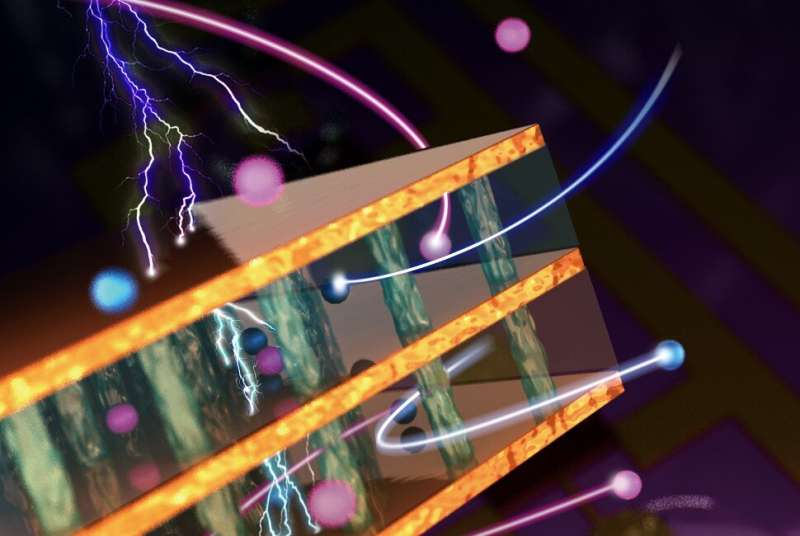Vertical electrochemical transistor pushes wearable electronics forward

A transdisciplinary Northwestern University research team has developed a revolutionary transistor that is expected be ideal for lightweight, flexible, high-performance bioelectronics.
The electrochemical transistor is compatible with blood and water and can amplify important signals, making it especially useful for biomedical sensing. Such a transistor could enable wearable devices for onsite signal processing, right at the biology-device interface. Potential applications include measuring heartbeat and levels of sodium and potassium in blood as well as eye motion for studying sleep disorders.
“All modern electronics use transistors, which rapidly turn current on and off,” said Tobin J. Marks, a co-corresponding author of the study. “Here we use chemistry to enhance the switching. Our electrochemical transistor takes performance to a totally new level. You have all the properties of a conventional transistor but far higher transconductance (a measure of the amplification it can deliver), ultra-stable cycling of the switching properties, a small footprint that can enable high density integration, and easy, low-cost fabrication.”
Marks is a world leader in the fields of materials science and organic electronics. He is the Vladimir N. Ipatieff Professor of Catalytic Chemistry in the Weinberg College of Arts and Sciences and professor of materials science and engineering and chemical and biological engineering in the McCormick School of Engineering.
The vertical electrochemical transistor is based on a new kind of electronic polymer and a vertical, instead of planar, architecture. It conducts both electricity and ions and is stable in air. The design and synthesis of new materials and the transistor’s fabrication and characterization required the collaborative expertise of chemists, materials scientists and biomedical engineers.
Marks led the research team along with Antonio Facchetti, research professor of chemistry at Weinberg; Wei Huang, now a professor at the University of Electronic Science and Technology of China; and Jonathan Rivnay, professor of biomedical engineering at the McCormick School.
“This exciting new type of transistor allows us to speak the language of both biological systems, which often communicate via ionic signaling, and electronic systems, which communicate with electrons,” Rivnay said. “The ability of the transistors to work very efficiently as ‘mixed conductors’ makes them attractive for bioelectronic diagnostics and therapies.”
This study detailing the efficient electrochemical transistor and an accompanying News & Views article were published this week by the journal Nature.
“With their vertical architecture, our electrochemical transistors can be stacked one on top of another,” Facchetti said. “Thus, we can make very dense electrochemical complementary circuits, which is impossible for the conventional planar electrochemical transistors.”
To make more reliable and powerful electronic circuits, two types of transistors are needed: p-type transistors that carry positive charges and n-type transistors that carry negative charges. These types of circuits are called complementary circuits. The challenge researchers have faced in the past is that n-type transistors are difficult to build and are typically unstable.
This is the first work to demonstrate electrochemical transistors with similar and very high performance for both types (p+n) electrochemical transistors. This resulted in the fabrication of very efficient electrochemical complementary circuits.
More information:
Wei Huang et al, Vertical organic electrochemical transistors for complementary circuits, Nature (2023). DOI: 10.1038/s41586-022-05592-2
Citation:
Vertical electrochemical transistor pushes wearable electronics forward (2023, January 19)
retrieved 19 January 2023
from https://techxplore.com/news/2023-01-vertical-electrochemical-transistor-wearable-electronics.html
This document is subject to copyright. Apart from any fair dealing for the purpose of private study or research, no
part may be reproduced without the written permission. The content is provided for information purposes only.
For all the latest Technology News Click Here
For the latest news and updates, follow us on Google News.

